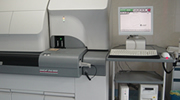[Health] Zhejiang Hospital completed the first case of internal thoracoscopy
Hits: 3289 Time: 2019-02-18
Experts guiding this article
Qin Guangyue
Chief physician, professor, master's supervisor, deputy director of the Department of Internal Medicine and director of the Department of Respiratory Medicine at Zhejiang Hospital. He is also the director of the China Sleep Research Society, the executive member of the Sleep and Breathing Disorders Committee of the China Sleep Research Society, the member of the Respiratory Physicians Branch of the Chinese Medical Association, the member of the Sleep Medicine Committee of the Chinese Medical Association, the vice president of the Respiratory Physicians Branch of the Zhejiang Medical Association, the vice chairman of the Respiratory Disease Branch of the Zhejiang Medical Association, the vice chairman of the Internal Medicine Branch of the Zhejiang Medical Association, the vice chairman of the Sleep Disorders Committee of the Zhejiang Rehabilitation Medical Association, and the chairman of the Pulmonary Function Alliance of Zhejiang Province。He has been engaged in clinical medical, research and teaching work in respiratory medicine for more than 30 years. He has rich clinical experience in respiratory pathology, respiratory physiology, critical care medicine, radiological intervention, snoring and sleep breathing disorders. He specializes in the diagnosis and treatment of lung cancer, chronic obstructive pulmonary disease, lung infections in the elderly, and sleep breathing disorders. He has published more than 50 papers, co-edited several medical books, and more than 10 provincial and ministerial scientific research projects.
(1)Specialist Clinic.
Tuesday morning (San Dun division)
Wednesday morning (Ling Yin division)
(2)Famous Doctor Clinic
Wednesday afternoon (every other week, Ling yin division)
The Department of Respiratory Medicine of Zhejiang Hospital successfully carried out the first case of internal thoracoscopy in January 2019.The old patient, Mr. Xu, was admitted to the hospital with "chest tightness and shortness of breath for more than 3 months". The chest CT indicated a large amount of pleural effusion on the right side, and the nature of the pleural fluid could not be clarified by lots of examinations. After all physicians of the Department of Respiratory Medicine discussed the patient's condition, Dr. Qin Guangyue, Deputy Director of the Department of Major Internal Medicine and Director of the Department of Respiratory Medicine of Zhejiang Hospital, had an analysis and summary on that. Meanwhile, after detailed communication with the patient's family, he performed internal thoracoscopy for the patient with the collaborative help of the Medical Department, Hospital Infection Management Section, the Department of Anesthesia and Surgery, the Endoscopy Center, and the Information Department.
With the healthy body side-lying position, the patient was cut 1.5 cm starting from the puncture point of intersection between the axillary midline and the 6th intercostal space after local anesthesia. The tissue was separated bluntly with curved forceps up to the pleural layer. Then a thoracic trocar was placed. An electronic bronchoscope was entered through the thoracic trocar to explore the thoracic cavity and biopsy the mural pleura for pathological examination. The procedure went smoothly, and the patient returned to the ward safely.
Internal medicine thoracoscopy is a safe and effective minimally invasive technique. The operation was done by a respiratory physician in the endoscopy room. With a local anesthesia and an awake patient, it only needed a small 1.5 cm chest wall incision mainly for diagnosis of thoracic diseases. Among them, pleural effusion whose etiology cannot be clarified by several non-invasive methods is one of the main indications for medical thoracoscopy.
The technique of internal thoracoscopy is one of the 10 technical requirements of the second-class technical index of respiratory medicine specialty in the tertiary care hospital. The Department of Respiratory Medicine of Zhejiang Hospital is mainly for elderly patients. The new technologies and projects have been developed in recent years. The successful development of thoracoscopic technology in the Department of Internal Medicine has brought the respiratory interventional technology of Zhejiang Hospital to a new level.
Related links: Thoracoscopy
Internal thoracoscopy is a less invasive operation that requires only a small incision in the chest wall for examination, establishment of an artificial pneumothorax followed by direct visual inspection of the microscopic pleural appearance to take a biopsy of the diseased pleura or for treatment. The indications are etiological diagnosis of unexplained pleural effusion and pleural mass, etiological diagnosis of diffuse or peripheral limited lesions of the lung, diagnosis and differential diagnosis of lesions of the mediastinum, diaphragm, chest wall and pericardium, etiological diagnosis and treatment of intractable pneumothorax, etiological diagnosis and treatment of intractable abscess chest, intrapleural removal of foreign bodies, etc., biopsy diagnosis of pleural mesothelioma, diagnosis, staging, selection of treatment and estimation of prognosis of primary lung cancer , selection of treatment methods and estimation of prognosis.
Advantages of endoscopic thoracoscopy: It could be performed in the bronchoscopy room rather than surgery room. We just need only 1~2 cm skin incision after the local anesthesia and intravenous sedation and analgesic treatment. So, the trauma was relatively small and the patient tolerated it well with high comfort. As for electronic thoracoscopy in internal medicine, it was easy to operate and inexpensive. That also reduced the cost burden for patients. With better promotion of the respiratory department's thoracoscopy activities, it will surely bring more benefits to the majority of patients with pleural effusion and pleural disorders. That also became a powerful diagnostic and therapeutic tool for the respiratory physicians. It promoted the construction of respiratory disciplines.
Edited by Jing; Reviewed by: Jun
Originated from: Department of Respiratory Medicine
Collecting and writing by: Jing Wu from Publicity Center





